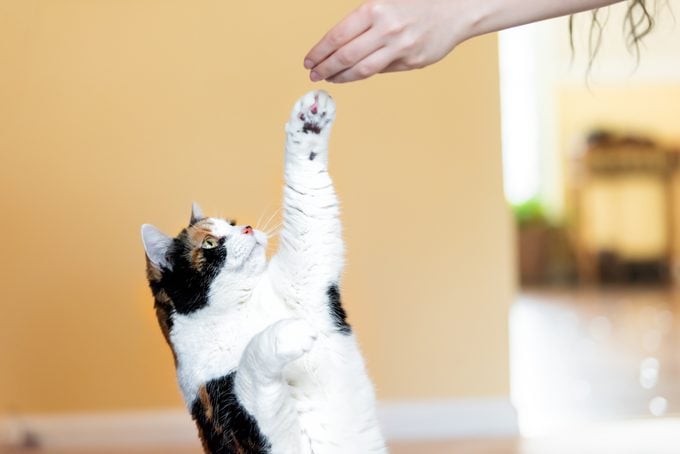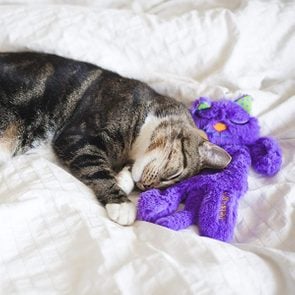How to Train a Cat: A Guide to Training Your Feline to Respond to Commands and Curb Bad Behaviors
Updated: Dec. 06, 2023

Yes, you can train a cat to come on command, walk on a leash and more—and it's all much easier than you probably think
Though cats can be pampered pets with an attitude that runs from fussy, curious and affectionate to aloof—all in the same hour—learning how to train a cat is important. Yes, this holds true even if you parent one of the cutest cat breeds and your kitty is so adorable, it could get away with almost anything. Not only is training your cat necessary for their health and well-being, along with the condition of your furniture, it’s also a really fun way to interact with your pet. The visible enjoyment some cats experience when they learn a new command or trick is one of the clear signs your cat is happy.
But some cat breeds, especially the smartest cat breeds, like to call their own shots (that sunny window is calling their name, after all), so how can cat parents motivate and train their kitty? In some ways, it’s similar to dog training, though training a cat does present its own unique challenges. But don’t worry, Reader’s Digest is here to help. You can also find out how long can you leave a cat alone.
Our comprehensive guide is the cat’s pajamas of cat training. It features expert intel from cat behavior experts on how to teach your cat what to do—and what not to do. So round up your smarty cat and get ready to learn a few new tricks together.
Get Reader’s Digest’s Read Up newsletter for more pet insights, humor, cleaning, travel, tech and fun facts all week long.
On This Page
Why is training your cat important?
It may be hard to fathom, but even seemingly lazy cats still retain an instinctual need to hunt, catch, kill and eat. “Hunting requires problem-solving, and it produces rewards (food) when successfully accomplished,” explains Stephen Quandt, founder of Stephen Quandt Feline Behavior Associates in New York City. Without purposeful activities, cats can become very bored, which in turn can cause them to eat and sleep too much or create their own “fun” by engaging in destructive behavior, like scratching, spraying and biting.
Your cat’s need for the mental stimulation of hunting can be satisfied with replacements like interactive cat puzzles, cat toys and cat training, all of which mentally challenge your kitty. Cat training, in particular, gives your cat opportunities to problem-solve and get rewarded for it. “The trained behavior is their ‘job,’ and the food is their ‘paycheck,'” says Quandt. Bonding with you, their person, is an added perk.
Are cats easy to train?
The short answer is: Yes. The longer answer? It’s a little more involved than that. “You can train a cat to do absolutely anything—anything it wants to do,” Quandt says. “Unlike dogs, who evolved with a social hierarchy and see people as pack leaders they want to please, cats don’t care about appeasing us because they evolved as a solitary species and are generally not as motivated to elevate themselves in a social structure.” So how do you train a cat when they aren’t invested in their social standing?
“Cats are motivated by positive attention, playtime and food—food is the biggie,” says Molly DeVoss, a certified feline training and behavior specialist and Vitakraft’s cat advisor in Dallas. “The secret to successful cat training is having a knock-your-paws-off treat that will entice them to behave in ways that might not be natural to them.”
Training methods for cats
When considering how to train your cat, there are a few different cat training methods you can use. The common thread is to radiate positivity, be super patient and have plenty of tempting treats on hand for rewards.
Positive reinforcement
Positive reinforcement–based training is about as simple as it gets. “Your cat does something you like, you reward them and the reward reinforces that behavior, so they do it again to get another reward,” explains Samantha Bell, cat behavior and enrichment lead for Best Friends Animal Society in Los Angeles.
How to use it: Let’s say you are training your cat to sit. When you see your cat sit, immediately reward them for sitting. That’s all there is to it. But it is essential to be clear and consistent, especially in the early days of training.
Clicker training
A clicker is a hand-held tool to mark your cat’s desirable behavior.
How to use it: In the above example, you would click the clicker the second your cat’s butt touches the ground in a sitting position. “The click signals to them the exact moment they did something you want to see repeated and gives you time to deliver the treat,” Bell explains.
Auditory marker
An auditory marker is a fancy way of saying that you should heap praise on your cat to mark the desired behavior, Bell says.
How to use it: Like with clicker training, it’s essential to speak your chosen word or phrase, such as “yes” or “good job,” immediately when you see the behavior and follow up quickly with a reward. Use the same word every time, so your cat learns to recognize it and associate it with positive things.
What to know before you train your cat

There’s no pussyfooting around it: Cats do what they want, when they want. For cat training to be effective and rewarding for both parties, you have to look beyond that cute face to find out what makes your kitty tick.
Size up your cat’s mood
“Before training your cat, learn to read their body language to see when they are enjoying something and when they are not,” says Bell. There will likely be days when your cat isn’t the least bit interested in cat training, and on those days, you don’t want to push it. “Patience and a positive attitude are so important in cat training,” Bell adds. “It is a partnership, and both parties should be having fun.”
Time it right
Though you should never withhold cat food or alter their feeding routine, it’s a good idea to train before your cat’s normal mealtime when they’re hungry. “Remember that a cat’s stomach is the size of a ping-pong ball,” Bell says. To prevent them from filling up too fast—which will effectively end a training session—she recommends breaking the treats into tiny pieces so you’ll have more rewards to dole out.
Reward immediately
When your cat does what they’re supposed to, you might react with excitement, pet your cat and then give the treat. But when you delay rewarding (with a clicker, praise or treat), your cat might not understand what they did to deserve it. “If we don’t mark exactly when the behavior happens, cats can become frustrated and confused and decide they don’t want to participate,” says DeVoss.
Teach one thing at a time
Cats are capable of learning many tricks and commands, but not all at once. “Teach only one behavior at a time, and only introduce a new skill once the previous one has been mastered and your cat performs the behavior on cue,” says DeVoss. Limit training sessions to a few minutes, tops.
What you need to train your cat
You don’t need to buy a lot of gear when training cats, but in addition to a clicker, one component is essential, says DeVoss: an irresistible treat. Experiment until you discover one that gets your cat’s motor purring, then reserve that treat only for training.
How to train your cat to follow commands
Your cool cat has been training you for some time. They use subtle tactics like meowing to remind you it’s feeding time or sit on your laptop to get your attention. Sneaky? Maybe. But it’s all good. “Cats will quickly think that they are controlling you, and a sense of control is essential for a cat’s well-being,” says DeVoss. Now, it’s your turn to teach them a few key commands.
How to train a cat to sit

Training a dog to sit is standard fare, but can you train a cat to sit? You sure can, and the same method used for dogs works for cats. This command is handy for grooming, vet exams or when you would like them to wait politely for their dinner.
How to do it: Using your treat as a lure, move it just above your cat’s head and back toward their ears. Your cat should tilt their head up to follow the lure, ultimately bending their back legs, which will result in the “sit” position. “As soon as your cat’s butt hits the ground and they complete the ‘sit’ position, click and then give them that treat you were holding,” Bell says. “Add the verbal cue ‘sit’ each time they do, so eventually they’ll learn to sit on command.”
How to train a cat to lie down
Why would you need to train a cat to lie down? It’s a good way to prevent cats from racing through an open door or keep them calm when meeting new people.
How to do it: “There are two primary techniques to teach a cat to lie down: capturing the ‘down’ or coaxing it,” says Quandt. To capture the down position, you simply wait for your cat to lie down, quickly mark it with an auditory marker (like “down”) and offer a treat. When your cat lies down again, repeat.
For coaxing, hold the treat in front of your cat and move your hand down to the floor to encourage them to lie down. Mark the behavior, give the treat and repeat. Just like when training a cat to sit, do this enough times and eventually they’ll learn to lie down every time they hear the “down” command.
How to train a cat to recognize its name
Cats recognize the sound of their food being poured into their dish, but do cats know their names? Yep! And it’s very useful when they’re hiding, they’ve gone missing or you want to get them to move away from something dangerous. Keep in mind that the best cat names are short and simple, so you may want to trim “Madame Fluffypants” to “Fluffy” for training purposes.
How to do it: Say their name, and then if your cat turns to look at you, offer a treat immediately. However, Quandt cautions, don’t overuse your cat’s name, and also make sure to phase out treats over time. “We don’t want ‘Peachy’ to just mean ‘treats.’ We want the word to mean: ‘It’s all about me. They’re calling me!'” he says. Try calling out their name from another room and have other people use their name too. Be sure to say your cat’s name when you’re petting or playing with them so they associate it with all good things.
How to train a cat to come
Teaching your cat to come is a valuable command. Have you ever “lost” your cat in the house and wondered where they were? Or needed to entice your cat to come out of hiding to take them to the vet? Then you know why this is an important one.
How to do it: It’s easy to get started. Just wait for your tabby to approach you. As soon as they start walking toward you, click the clicker, then give them a treat. Next, throw a treat away from you so they are farther away. This is called a “reset,” Bell says. Then, hold up a new treat while saying, “Come!” Click and give them a treat when they are closer to you than they were before. “Reset and continue in this manner until your cat has come all the way to you,” says Bell.
Handy things to teach your cat

“Training a cat to use a litter box, go in a carrier or walk on a harness and leash are all behaviors with important benefits,” says Quandt. The commands can keep your cat safe, healthy and happy.
How to train a cat to use the litter box
Lucky for you, you probably won’t have to train a cat to use a litter box because most kittens and cats instinctively know how to use one. “If you show a kitten a litter box, they will most likely start using it, particularly if the litter substrate is soft and sand-like,” says Quandt. Their natural inclination to do their business in a litter box probably stems from instinct: Outdoor and wild cats bury their poo to prevent them from being tracked by larger predators.
How to do it: Set them up for success by providing a quiet and private space, as kitty cats covet their privacy. But don’t put the litter box near their food and water because cats aren’t keen about eating next to their bathroom. (Can you blame them?) Be sure to scoop the litter daily or invest in a self-cleaning litter box.
How to train a cat to go in a carrier
It’s no wonder many cats run for the hills when they see a cat carrier taken out of the closet. The stress and fear of being wrangled into one for a yearly visit to the vet doesn’t make for warm and happy memories for either of you. Wouldn’t it be great to learn how to get your cat into a carrier without getting scratched? Before you start, invest in a carrier with a front door that your cat can easily enter and exit.
How to do it: First, place a towel that your cat has laid on (depositing its scent in the process) in the carrier. Next, start placing your cat’s food bowl just outside the carrier. Then, with each meal, start moving the food bowl just inside the carrier, then further inside until it’s all the way at the back. Toss treats and toys in the carrier between meals to create a fun and relaxing place for your kitty to hang out. A towel over the carrier may help give it that cat-cave vibe felines love.
When your cat goes inside to hang out or nap, close the carrier door for a few minutes at a time. After repeating this several times, take your cat in its carrier on a short walk around your home, then return to the starting location and open the carrier’s door, advises Quandt. Eventually, take your cat and carrier to the car and just sit there. Work up to turning on the car’s ignition, and finally take a short drive. “After acclimating to these short trips, you can take a drive with purpose, like to a vet,” he says.
How to leash-train a cat
Training cats to walk on a leash may seem odd, but it can come in very useful when you’re taking a road trip and stop for exercise, or when you’re flying with a cat and TSA needs you to take your cat out of its carrier. Not to mention, it can be fun to take a walk together around the neighborhood! But don’t be surprised if your cat has a different walking style than a dog. “Most cats simply want to lie down, roll around and meander, and they don’t walk in a straight line,” says Bell.
How to do it: Leash training takes time. Reinforce each step five times before moving to the next, and work on only one step per day. Always mark with a clicker or other cue, and reward your cat with treats immediately.
Begin by draping a piece of string on your cat’s back to get them used to the feeling of something lying on them. Once they’re accustomed to it, move on to a slightly heavier material, such as a ribbon or small scrap of fabric. Meanwhile, show your cat the harness, allowing them to sniff, touch or rub against it.
For the next steps, place their head in the harness for just a few seconds, increasing the duration with each session. Then, with one hand resting lightly on the harness and a treat in the other, move their head through the harness, allowing them to feel a slight weight of the harness on their back. Once that’s mastered, move their head in the harness with the full weight of the harness on them.
Now your cat is ready for you to attach the harness on one side and, once they’re comfortable with that, clip the other side. For the final two indoor sessions, attach the leash to the harness, and let your cat drag it around your home. Then hold the attached leash while your cat is wearing the harness and walk indoors.
The final lesson is taking your cat for a walk outside with a leash and harness. Even if all goes well inside, remember some cats just don’t love the great outdoors. “A timid cat may never enjoy being outdoors, no matter how patient you are or how well the training indoors goes,” notes Bell.
How to train your cat to do tricks
Training cats to do tricks is fun and also has some health benefits for your little lion. Cats sleep a lot, and over time, they can get a little too comfy just lounging around. Learning new tricks encourages physical activity to help maintain a healthy weight and mental activity to prevent boredom. Patience, consistency and rewards are the keys when training a cat to do fun cat tricks.
How to train a cat to high-five

Training cats to do a high-five is one of the easier tricks because it’s second nature for cats to touch things in front of them.
How to do it: Begin by showing your cat your palm just above its head. Wait for your cat to touch your palm with their paw. Immediately click at the precise time the paw touches your palm and give the reward, Bell says. Now, remove your hand, wait a few seconds and repeat the process, saying “high-five.” In time, you’ll be able to command “high-five” and your cat will touch your hand.
How to train a cat to fetch
Training cats to fetch requires a different approach than it does with a dog. “It is much easier to reward your cat for bringing you a toy than it is to teach a cat that doesn’t naturally interact with toys to start returning them to you,” says DeVoss.
How to do it: Use a clicker or auditory marker at the precise time your cat picks up the toy, then follow with a high-value treat. “Once your cat is consistently picking up the toy, step away and call them to you. Mark and give a treat when they come to you with the toy,” DeVoss says. The next step is to toss the toy and say “fetch” as they pick it up, she says. Be sure to mark and reward when the cat returns the toy to you.
How to train a cat to spin
Wouldn’t it be fun to teach your cat to do a simple spin like models do on the catwalk? This little trick is well within your cat’s ability (and yours).
How to do it: Start by holding your index finger a few inches in front of your cat’s nose. When your cat touches your finger with their nose, say your choice of auditory marker when they touch your finger and deliver a high-value treat. “Once your cat consistently touches their nose to your finger six times, begin moving your finger away so they have to take a few steps to complete the touch,” advises DeVoss. “Mark and reward when they do it successfully.” Next, begin to lure your cat with your finger in a circle. When your kitty makes a half circle, mark and reward, then keep moving your finger a little farther along each training session. Once they follow your finger in a whole circle, say “spin” and reward them with a treat.
How to train a cat to roll over
How to do it: Wait until you catch your cat lying down on their side, then hold a tasty treat in front of their nose and lure them with an arc movement to roll over onto their back and other side. When your kitty rolls over completely, use your marker and give them a treat. You can say “roll over” as they are about halfway through, followed by the marker and reward when the behavior is complete, says DeVoss. With practice, you should be able to move your extended index finger in an arc gesture and say “roll over.”
How to correct bad behavior in cats
Cats are undeniably cute, cuddly and lovable, but beneath those furry bodies lies a little lion that still has wild instincts that must be satisfied. If they’re not, it can result in biting, scratching, digging up potted plants and other unwanted behavior. Here are some strategies for providing a nurturing and harmonious home—for both of you.
How to stop a cat from biting
Ever wonder why your super affectionate cat rubs against your face and then bites you two seconds later? Chalk it up to instinctive behavior. “All cats have to bite and scratch,” says Bell. “You can’t extinguish instinctive behaviors or it will cause animals great stress.” The key is to introduce things that are OK to bite and to reward them for using those.
How to do it: The next time your cat bites you, ignore it and walk away. Return with a wand toy that is long enough to keep your hands out of reach of sharp kitty teeth. Then, when they bite the wand toy, reward them with treats and praise.
Soon your cat will realize that biting humans does not provide any reward or fun, and they will reserve biting for their toys. Alternatively, if you want to add another feline to your family, adopting another cat may help. “My cats bite each other all day long and have a great time doing so,” Bell says. “They get the biting out of their systems and don’t need to bite me!”
How to stop a cat from scratching furniture
The first thing you should know is that scratching is a perfectly natural part of a cat’s daily life. Scratching removes the dead part of their nails, helps them get a good stretch in their legs and marks their scent on the area from the glands in their paws. As tempting as it is to shout “No!” or clap your hands to stop them, it’s actually more effective to say yes. As in, yes … but please use a scratching post instead.
How to do it: The key is to find a scratching surface your cat likes the best. “In the wild, cats scratch on trees,” says Bell. Sisal rope and natural wood are the cat’s meow for materials that mimic the feel of bark. To encourage use, “pick scratchers that are tall and sturdy enough for them to really put all their weight behind during a big stretch,” she says. Not a fan of cat scratching posts in the living room? Consider buying a cat-proof couch.
How to keep cats off counters

Knowing how to train a cat to stay off the counters involves gathering some intel on why your cat likes it so much, then tailoring your approach.
How to do it: “If your cat is getting on the counter because they are curious and interested in what you are doing or cooking, provide the cat with a special perching spot such as a barstool or cat tree,” says Janna Skinner, a cat behavior manager at the Arizona Animal Welfare League in Phoenix. That way, they can still see what’s going on, but they are not on the counter in your way. Or, your cat might be leaping up to the counter to stay away from a child or another pet. “Provide them with a cat tree or use a pet gate to create a ‘safe zone’ for the cat in a spare room,” Skinner suggests. Be sure to reward your cat when you spot them perching in their new special place.
How to stop your cat from spraying
Yes, it’s smelly and gross, but oddly enough, spraying serves as a communication method for some cats and by no means warrants punishment. “Spraying or vertical urine marking is nearly always a territory issue,” Skinner says. “The single best way to deter spraying is to make sure all cats in the home are spayed or neutered.” Still, even spayed and neutered cats can spray when there is conflict with another cat.
How to do it: If that’s the case, ensure the sprayer of the duo has plenty of their own space to move around freely—including higher vertical spaces cats covet for privacy and observation, Skinner says. You can also try feline pheromones to help your kitty cat feel more comfortable.
How to stop your cat from peeing on the floor
Cats instinctively know how to use their litter box, so when a cat pees on the floor, it could be a sign your cat needs to see the vet. Often, the culprit is a urinary tract or kidney infection. If you get the all-clear from the vet, there might be something about the litter box area that the cat doesn’t like, Skinner says.
How to do it: Make sure the litter box is the right size—a general rule of thumb is that it should be 1.5 times your cat’s body length, says Skinner. When it comes to the types of cat litter, opt for soft and unscented. Cats have super-sensitive noses, and some fragrances are overpowering to them. Finally, privacy is key. “Place the litter box in a private, well-lit area that is not too far from the main area of the home,” says Skinner. “Make sure children and pets cannot bother the cat while they are using their litter box, and if you have more than one cat, keep multiple litter boxes in different areas of your home.”
How to keep cats away from your indoor plants
Hanging plants and potted trees are oh-so-tempting, and they can literally be intoxicating to kitties, as many common houseplants are poisonous to cats. But there is a way to get them to coexist peacefully.
How to do it: The best way to keep houseplants and cats safe is to put plants in hanging planters or on inaccessible shelves. You can also keep your cat from becoming interested in your plants by providing them with their own little cat-safe mini garden of cat grass and catnip—two plants that are safe for them to snack on, says Skinner.
How to keep cats out of your yard and garden
“Cats can be great garden helpers when they hunt bugs or rodents that can damage garden plants,” says Skinner. “However, cats are not so helpful when they act like the garden is a giant litter box.” But luckily there are a few things you can do to keep them out of your yard and garden.
How to do it: Add scent and/or texture to discourage digging. Cats typically turn up their noses at orange, lemon and coffee scents, so try sprinkling orange and lemon peels or wet coffee grounds around your plants. Or, “to deter cats using texture, plant some ‘scat mats,’ special mats with soft spikes that go under a thin layer of soil to deter animals from walking through or digging in gardens,” says Skinner.
What to do if cat training isn’t going well
- Try a new treat. Cats aren’t motivated by mediocre treats.
- Go slow, and break down the lesson into smaller steps. This will coax your cat to perform the specific desired behavior.
- Scale back training sessions. Just a minute or two may be more manageable for your kitty and have a much bigger impact.
- Don’t fall for their tricks. When learning behaviors, your cat may test you. For example, they may touch a different finger to see if that results in the reward. When you are being tested, make it clear to your cat that only the behavior you are working on gets rewarded.
- Take your cat’s mood into account. Don’t attempt training when your cat isn’t feeling well or napping. Distractions from noise, pets or other people may also lead to a frustrating and ineffective training session.
About the experts
- Stephen Quandt is the founder of Stephen Quandt Feline Behavior Associates and is a Feline Training and Behavior Specialist certified through the Animal Behavior Institute. He is a professional cat behaviorist with more than 20 years of experience working with cats in private consultations, animal shelters and rescue work with the ASPCA and Animal Care Centers of NYC. He is the owner of two cats, Jenny and Cricket.
- Molly DeVoss is a Dallas-based certified feline training and behavior specialist (CFTBS), a certified cat behavior consultant (CCBC), a fear-free certified trainer (FFCT) and the founder of Cat Behavior Solutions and the weekly podcast Cat Talk Radio. She specializes in using positive reinforcement to modify and prevent unwanted behaviors in cats, reducing cat-shelter surrender in the process. She is also an advisor for Vitakraft cat treats and the proud owner of one cat, Pico de Gato, plus a revolving door of medical and underage kitten fosters.
- Samantha Bell is the Los Angeles–based cat behavior and enrichment lead for Best Friends Animal Society and a member of the International Association of Animal Behavior Consultants. She is also a trainer-mentor for the Jackson Galaxy Project’s Cat Pawsitive program and trains staff and volunteers at shelters and rescues around the country on how to clicker-train their cats to help solve behavior issues and get them adopted. She’s a cat parent to three cats, Yohan, Desmond and Maurice.
- Janna Skinner is the feline behavior manager at the Arizona Animal Welfare League (AAWL), Arizona’s largest and oldest no-kill shelter. Skinner is a certified cat trainer from the Animal Behavior College. At AAWL, she works as a cat behavioral expert, improving behavior modifications as well as creating guidelines for behavioral plans for cats and kittens in their care. Skinner has seven cats of her own, Meep, Painted Lady, Peanut Butter, Taco, Fleetwood, Rudy and Chopstick.





